A round-up of my reviews for non-Criterion movies in the past month.
IN THEATRES...
* The Beaver, Jodie Foster directs Mel Gibson, who talks through a beaver puppet. Yes, it's pretty crazy.
* Bridesmaids, this Kristen Wiig-led comedy is a real winner. Funny and heartfelt. And next time someone asks if Bridesmaids is a chick version of The Hangover, ask them if that's a stupid person's version of a smart question.
* Cave of Forgotten Dreams, Werner Herzog's 3D documentary about the Chauvet Caves. My favorite movie of the year so far.
* Everything Must Go, in which Will Ferrell drinks some sad beer, channels Raymond Carver, and is pretty good at doing it.
* Hesher, Joseph Gordon-Levitt stars as the title character. Hit an open chord, take off your shirt, and be a teenage dirtbag, baby.
* Thor, another winner from Marvel. Kenneth Branagh's adaptation of the comic is mighty fun.
* True Legend, a disappointing new action flick from the awesome martial arts choreographer Yuen Woo-Ping. Lame story, too much CGI.
The NW Film Center in Portland also had a festival of twelve films starring Catherine Deneuve. I picked some of my favorites for the Portland Mercury. Read "The Two Faces of Deneuve."
I also wrote blurbs for older movies doing the revival rounds:
* Sergei Eisenstein's Battleship Potemkin
* Claude Lanzmann’s Shoah
ON DVD/BD...
* Araya, Margot Benacerraf's 1959 blending of fact and fiction on the salt marshes of Venezuela.
* Bananas!*, a documentary about the fight against Dole Fruit, accused of poisoning Nicaraguan workers in the 1970s.
* The Captive City, Robert Wise's by-numbers anti-crime PSA from the 1950s.
* Guy and Madeline on a Park Bench, an intriguing mash-up of classic indie cinema and classic movie musicals.
* Henri-Georges Clouzot's Inferno, a stupendous documentary sifting through the remains of the Diabolique-director's unfinished would-be masterpiece.
* Hold On!, Herman's Hermits come to America, join the space race, play some music, pitch some woo.
* The Misfits, John Huston directs Clark Gable and Marilyn Monroe in their final screen roles. Also stars Eli Wallach and Montgomery Clift, in a script by Arthur Miller.
* Not as a Stranger, starring Robert Mitchum as a doctor who can heal anything but his own bad impulses. Directed by Stanley Kramer.
* Shoeshine, a Neorealist classic from Vittorio De Sica, released 1946.
* The Unloved, Samantha Morton's softly rendered, heartfelt directorial debut.
Tuesday, May 31, 2011
Monday, May 23, 2011
THE GREAT DICTATOR (Blu-Ray) - #565

A little historical perspective: In 1937, though Adolph Hitler's power was growing and his unctuous policies were becoming increasingly well-known, the world was not yet at war with Germany. On the contrary, until late that year, Hitler was still in negotiations with England to try to maintain an alliance across Europe. So, it was with some incredible foresight and more than a little guts that Charles Chaplin, the biggest movie star in the world, began filming The Great Dictator, a satirical send-up of the hated world leader and everything he stood for. Who knows what the reaction to the film would have been had it been released earlier than 1940, but Chaplin's notoriously slow shooting schedule meant that the world had time to catch up before The Great Dictator was completed. By that juncture, the tide had turned and the movie hit at just the right time. In fact, following Germany's invasion of France, Chaplin rewrote his ending, changing it to the now famous call to arms. The Great Dictator would have been a remarkably different movie without it.
Though The Great Dictator wasn't Chaplin's first motion picture with sound--1936's Modern Times [review] was shot with minimal recorded dialogue but it was ostensibly made like a silent--it is considered his first full-on talkie in that it's his first with scripted dialogue from start to finish. For the occasion, Chaplin cast himself in two roles: a Jewish barber suffering persecution in the ghetto of the fictional country of Tomania, and Adenoid Hynkel, the cruel Phooey (a play on "Führer") making everyone's life miserable. Adenoid Hynkel is said to have come to life when Alexander Korda pointed out to Chaplin that his Tramp character had a very similar moustache to Adolph Hitler. Indeed, this similarity will be exploited in the final scenes of The Great Dictator when the two characters are mistaken for one another. (Though Dictator is not considered a Tramp picture per se, Chaplin does wear the outfit and keeps the rectangular nose neighbor.)

Most of Tomania is invented, even if the characters have real-life analogues. The base of the parody rests in silly puns and slapstick. Hynkel's right and left-hand men are Herr Herring and Herr Garbage; his ally and rival from the country of Bacteria is Benzino Napoli. The two despots fight over the right to invade Osterlich (most often pronounced like the bird "ostrich"). Hynkel's party has a logo comprised of two Xs, known as the Double Cross. When the dictator slips into fake German, it's mostly gibberish, with words like "sauerkraut" and "schnitzel" mixed in. It's not subtle comedy, to be sure, but it's damn funny. In particular, our first view of Hynkel is him leading a large rally and addressing his minions. Chaplin has clearly studied Hitler's speeches and catalogued his gestures and verbal idiosyncrasies. He shouts and flails and snorts and spits, breaking the rant for goofy pantomimes with a water pitcher, including dumping a glass in his pants. Later, he and Benzino Napoli (Jack Oakie) get in a food fight. It's humor that both plays to the audience's expectations and serves a purpose: the idea is to make these horrendous men seem as ridiculous as possible, and by doing so, deflate their power. The greatest compliment you can give them is to take them seriously.
Chaplin saves the serious stuff for the other plot, the Jewish ghetto where the barber toils under threat of having his head bashed in by stormtroopers. Chaplin's character is a hero from World War I who has been laid up in hospital with amnesia since that conflict ended, and he returns to life in Tomania unaware of the Double Cross. He quickly runs into trouble with Hynkel's thugs, though a pretty girl's frying pan and providence get him out of it. The pretty girl is a neighbor played by Paulette Goddard, and though somewhat underdeveloped, the romantic B-plot adds a sweetness to The Great Dictator. There is a charming sequence where the barber experiments with being a beautician, and he helps Goddard look and feel like a woman for the first time in her life. It's quite touching. Chaplin smartly knew that his movie needed heart to win over its audience. People react better to fighting for something specific, like the man or woman they love, than they do larger concepts. The masses can preserve the big ideas, but only you can protect what's important to yourself.
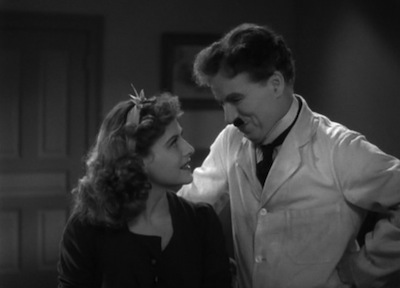
Otherwise, there isn't much sugarcoating in terms of how the ghetto is portrayed--you know, excepting the slapstick chases through the streets. Hynkel's men paint the word "Jew" on the windows of shops with Jewish owners, they freely steal from their victims, and the threat of concentration camps loom. While, granted, we know now how much worse the ghettos and the camps were than what Chaplin depicts in the movie, the full extent of the atrocities were not yet known during production. Even so, it's bold to present the anti-Semitism as it was and not dress it up in cute language or gags. The filmmaker was not looking to hide the film's message. He wanted his opinion of Hitler and Nazi policy to be very clear. Sure, some of it is heavy handed, just as some of the dialogue and supporting performances are clumsy--for all his craft, talkies still weren't Chaplin's thing. Unsurprisingly, The Great Dictator's most beloved sequence is the private ballet Hynkel undertakes with a balloon globe. Here the satire actually gets far more subtle, a dark message delivered in the lightest and most delightful manner possible: such capricious treatment of the world will only lead to its destruction.
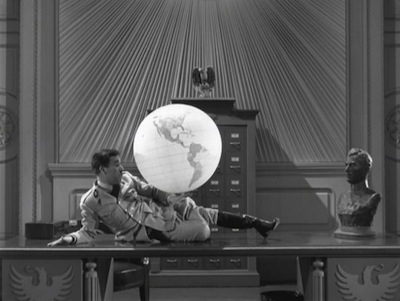
I think Chaplin can be forgiven for the bluntness of the propaganda. It was a different time, and different measures were required. The closing speech, in particular, must have felt absolutely crucial. The Jewish barber appeals to people of all nations, resorting to few of the histrionics his twin is known for, letting the import of the words do most of the work. The delivery is emphatic, with Chaplin looking directly into the camera, rallying the brotherhood of man to come together for a brighter tomorrow. It would be easy to be cynical and crack wise and minimize the scene if it weren't still so poignant, still so right on. For as stirring as it is, it's also rather sad that the message is no less true today than it was seventy years ago. Sinister forces still work to enslave us, man still betrays his own best interests to fuel the global machine, and the warnings Captain Schultz (Reginald Gardiner) gives to Hynkel could just as easily be applied to Guantanamo Bay and waterboarding. The deadly folly concocted by cruel minds appears to be history we are doomed to repeat.
Hell, it might even be worse now. Could you imagine any studio ever greenlighting a film like The Great Dictator today, much less a star of Chaplin's power signing on for the project? Try to imagine Jim Carrey playing Saddam Hussein or Ben Stiller as Osama Bin Laden during the early days of the so-called War on Terror.* It never would have happened. We don't have the guts to laugh that way anymore. Too many people would be offended for too many reasons. Is that maybe the cruelest, most divisive trick of all? If we can't laugh together, we can never join together to truly be free.
Criterion continues to use Blu-Ray technology to their best advantage with another stellar release: the new HD transfer on The Great Dictator looks remarkable. The surface image is clean, the resolution is sharp, and the black-and-white is perfectly rendered, with excellent balance between light and dark. I suppose one day I will turn cynical and these impressive restorations will start to look like old hat, but right now, I'm still overwhelmed by what can be done with classic films.
The bonus section is packed with a lot of great extras, including a new scholarly commentary and two video essays taking a more in-depth look at the movie. In addition to this, we get the intriguing TCM documentary The Tramp and the Dictator, which examines the movie and the parallels between Chaplin and the man he was lampooning.
There are also some fun comparisons of different barbershop scenes from earlier Chaplin movies, material that served as foundation for similar sequences in The Great Dictator.
Most pleasing, however, is the inclusion of the wonderful Al Hirschfeld drawings from the original Great Dictator press book. Criterion reprints them inside the supplemental booklet that comes with this release, alongside vintage essays about the movie and its final speech. Though not part of that old program, I can't help but enjoy the Hirschfeld portrait of Chaplin below, and so I share it here:
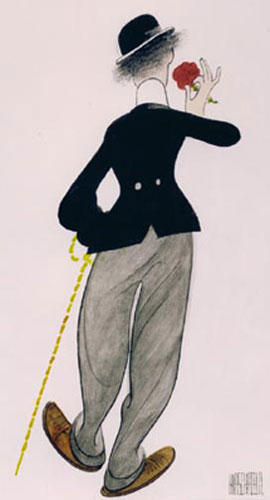
* South Park, of course, proves a notable exception to the rule. Sacha Baron Cohen is also currently in production on a Saddam Hussein movie, and it will remain to be seen if there is enough safe distance. The moviegoing public may still reject such a thing if the tone is too light.
This disc was provided by the Criterion Collection for purposes of review.
Wednesday, May 18, 2011
DIABOLIQUE (Blu-Ray) - #35
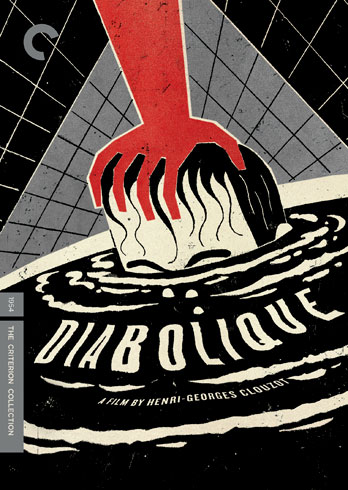
I first saw Henri-Georges Clouzot's 1955 thriller Diabolique by accident. It must have been 1995 or thereabouts, back when I was editing a comic book called Triple-X
Well, nothing, as it turns out. I had rented the wrong movie. They meant Danger: Diabolik

Diabolique is one hell of a genre picture, one that plays with the twisty conventions of a Hitchcock movie, wringing all of the horror out of the scandalous scenario it possibly can, while also building a movie full of pro-women proclamations and enough double-crosses to compete with the best film noir. The director's wife Vera Clouzot stars in Diabolique as Christina Delassalle, a language teacher whose dowery subsidizes the school run by her no-good husband Michel (Paul Meurisse). Michel is cheating on Christina with another teacher, the cynical blonde Nicole (Simone Signoret). The two women, the wife and the mistress, work side by side, giving them opportunity to compare notes. Both have plenty of reason to hate Michel. At the start of Diabolique, Nicole has to wear dark sunglasses because Michel has been smacking her around and she has a black eye. Oh, and did I mention that Christina is sickly with a heart condition? Yeah, if Michel survives this movie, he's got one hell of a career in politics ahead of him.
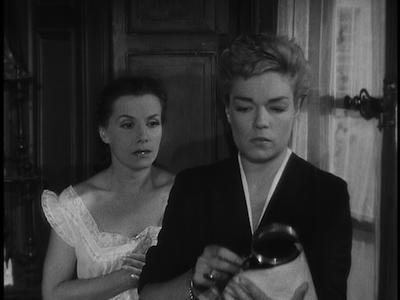

And surviving this movie will be his challenge. The ladies are looking to take the opportunity of a three-day weekend to enact a murder plot and take care of Michel once and for all. That's right, the sisters are going to do it for themselves, setting aside their differences to take care of the one thing that plagues them both. Their scheme involves poisoning and drowning--the rest, well, keep it schtum. The ladies play to type, with Christina being nervous and increasingly unhinged and Nicole being more calculating and determined. Both are excellent and they play off each other well, particularly as Christina's nerves start to affect Nicole. Simone Signoret, we know, is good at being in charge, but she's also excellent at falling apart.

On the same track, Paul Meurisse plays a real convincing creep. He is sneering and snide and just nasty enough that he never really crosses over into caricature; Michel ends up being an honest-to-goodness villain. You'll be rooting for him to get what's coming his way. Diabolique's after-plot involves transporting the body for discovery in a place far from where the ladies have established their alibi--which is when things go weird. Clouzot employs every trick in the book to give his gals a fright. We even tread into some territory straight out of ghost stories. Whose face is that in the window in the class picture? Could it be...?
Diabolique is as tightly wound a film as you're likely to find. It's a remarkable thing watching all the pieces move into place, like observing the interior of a well-designed clock. Gears turn, springs stretch and contract, every element does its part to ring the hour. Clouzot shot on what looks like real sets, choosing interiors with lots of doors and intersecting corridors. He also puts silence to use, letting moments linger, the ambient noise of the surroundings adding to the suspense. The director never tips his hand to what is really going on, there is no winking to the audience, it all comes across with a very straight face. Just try not to get sucked in. Go on, try!
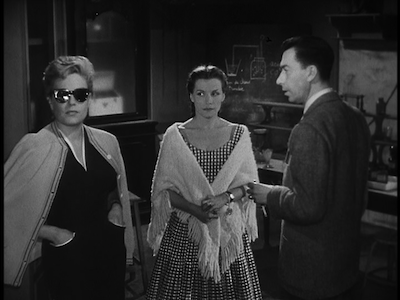
Diabolique was an early entry in the Criterion Collection, and the thirteen-year-old DVD was more than ready for an upgrade. The new high-definition transfer on the Blu-Ray is flat-out gorgeous. The overall image quality is crystal clear, with lovely renderings of black, white, and all the grays in between. Digital noise and scratches have been erased, making for a spotless viewing experience. No distractions here, you can just get caught up in the story, no tsk tsking at DVD glitches.
Amongst the trio of new extras on this disc, which consist mostly of critical commentary by admirers of the film, is an introduction to Diabolique by director Serge Bromberg. Bromberg is the director of the full-length documentary Henri-Georges Clouzot's Inferno, which I was also lucky enough to review on Blu-Ray recently. Though Bromberg's film doesn't dig too deep into Clouzot's earlier filmography, one can easily see how obsession and an attention to detail led to the influential director making such exacting motion pictures. L'enfer, the unfinished film unearthed in Henri-Georges Clouzot's Inferno, was a movie that tried to bring jealousy to life. It starred Romy Schneider as the object of these delusions, and it's a shame no one ever cast her and Simone Signoret to play daughter and mother. I can't be the only one to think they look alike!
Special note should be made of the new packaging of Diabolique. Criterion contracted David Plunkett to provide the awesome illustrations for the cover of the case and also the cover of the interior booklet. The images cross simulated woodcut techniques with classic poster design to create pulpy illos that would be at home on any spinner rack selling dime novels. Check out more from Plunkett and Spur Design at their website.
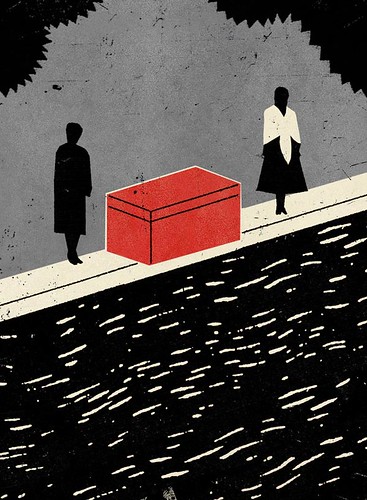
This disc was provided by the Criterion Collection for purposes of review.
Screen captures are from the DVD, not the Blu-Ray.
SIDELINE: LIAR'S KISS by Eric Skillman and Jhomar Soriano
Longtime Criterion fans certainly know the name of Eric Skillman, the graphic designer whose art process has made titles like Berlin Alexanderplatz and The Furies looks so incredible. Eric is also the one who ropes in all the comic book artists, like Mike Allred and Sean Phillips, to do covers for the collection, so no surprise, then, that he loves comics and has written his own debut full-length.
Liar's Kiss is out today from Top Shelf comics. It's a hardboiled crime story drawn by Jhomar Soriano. Preview it on the Top Shelf website by clicking on the cover image below.
I've got a copy waiting for me at my local comic book shop. You can go to your nearest comic book store, or order online.
Liar's Kiss is out today from Top Shelf comics. It's a hardboiled crime story drawn by Jhomar Soriano. Preview it on the Top Shelf website by clicking on the cover image below.
I've got a copy waiting for me at my local comic book shop. You can go to your nearest comic book store, or order online.
Monday, May 16, 2011
PALE FLOWER (Blu-Ray) - #564
"It's so pointless.""Yeah, it is."
No, that's not the dialogue of two bored teenagers who've just discovered black turtlenecks and Edith Piaf. It's an exchange between a thrill-seeking gambling addict and the yakuza who loves her, the main characters in Pale Flower, Masahiro Shinoda's 1964 portrait of underworld ennui. These are doomed souls on a collision course with one another, an interpersonal big bang that can only spell their tragic end...though, as the poem goes, it's an end that will merely whimper. It's an implosion more than an explosion.
The dual nature of Shinoda's scenario is established from the very first scene. In voiceover, the hardboiled criminal Muraki (Ryô Ikebe, Early Spring [review]) quickly explains that he has only just gotten out of prison after serving three years for killing another man. The whole sordid affair has left Muraki with a particularly nihilistic worldview. He took a man's life, but the rest of the world carried on. Life is indifferent to those who live it. Yet, the moment that Muraki lays eyes on Saeko (Mariko Kaga, Snow Country, Only on Mondays) in the gambling den, the gangster endeavors to change her fate and keep her safe. He is an ex-con white knight, swooping in to protect the fair maiden. He jumps in the game, interrupting her losing streak by starting one of his own. If only one of them can win this bet, it might as well be her.
The pair develops a relationship after that, though it's one that is never sexual. Saeko sees Muraki as her entry into higher-stakes games. Whatever life she has outside of the late-night gambling, she keeps it separate. We can guess she's probably from a respectable family well before Muraki accidentally runs into her with her friends. This is a girl of privilege with a yen for danger. She ponders bigger bets hoping that they will give her even more of a jump, she races other drivers on the highway, and naturally, when she hears the half-Chinese gangster Yoh (Takashi Fujiki) is a junkie, she becomes fascinated by him and his deadly habit. Muraki, resigned to the role as the "older brother," warns her against going on the dope, but even he knows it's pointless.
Because, though he may forget, it's all pointless. Symbolically, Muraki is a man whose time is limited. The lover who waited for him all these years (Chisako Hara) is our first indicator that the clock is ticking--in her case, quite literally. Her father owns a clock shop, and when Muraki returns to her, the persistent metronomic clatter serves as soundtrack to their lovemaking. This has been the woman's jail while Muraki has been behind bars; her life has been in stasis. Her devotion has also been a waste. When a fellow from her office offers to marry her, Muraki tells her to go for it, to take the normal life while she can. Perhaps he's trying to save her, too, but of anyone, she seems most aware of the troublesome mortality that defines their romance.
Indeed, Muraki is going to get a reminder that his position is tenuous in the very next scene. A friend of the man he killed tries to take revenge, even though the rival gangs have formed a truce since Muraki went inside. Ironically, Muraki takes the younger man (Isao Sasaki) under his wing after this, prepping him for greater things. Shinoda underscores this fateful first meeting with a subtle orchestral version of the Elvis Presley song "It's Now or Never." Live for the moment, Muraki, it's all you have.
Music plays an important role in Pale Flower. Shinoda and composer Toru Takemitsu draw on a variety of influences to establish the story's various moods. At one of the more crucial nights out, the game where Muraki realizes that Yoh is a threat, the soundtrack adopts more traditional Japanese sounds. Dissonant horns and chaotic percussion, combined with the ambient noise of the game itself, create a feverish mood, reducing the players to their most primal equation: Adam, Eve, and the Snake. This will be reinforced in the film's climactic scene, when the operatic events demand operatic music. Shinoda has given us various hints throughout Pale Flower that a shift toward more Western ethics and behavior is occurring, and here, besides, the music, the church-like decorations emphasize the particular moral landscape of this scenario. Muraki hopes to dissuade Saeko from chasing her various metaphorical dragons any further and simultaneously defeat his rival by showing her the one thing he believes Yoh can't conjure. In a way, it is the ultimate sacrifice he can make: he isn't literally giving up his life for her, but he is giving up his freedom, which itself will consign him to a kind of walking death. Still breathing, but exiled to purgatory.
It's a gamble, but then, the whole of life is a gamble. The game of luck that Saeko and Muraki play is one of pure chance. The players randomly draw hanafuda, colorful dominoes with pictures on them, and place wagers on whether or not they will draw a match to the domino played by the lead gambler. It's a conundrum we regularly take in life: if I put myself out there, will this other person match up, will we be compatible. For Saeko, Muraki is a new kind of danger. She tells him at one point, "I'm so bored with life," and she uses him to find fresh excitement. What he sees in her glass-eyed expression is something only he knows. Maybe it's a kindred spirit, maybe it's himself as he once was, making her his second chance. Regardless, he's foolish to think it will make any difference. She so much as warns him. "Whatever happens, I forgive myself," she says. In other words, she lives for her own sake first, and whatever she has to do to bring herself whatever pleasure or contentment she can find, she'll do it, anyone else be damned.
It's enough to make you wonder who the real nihilist is here! Pale Flower's philosophical landscape is as desolate as any American film noir, and its actual landscape is shot with just as much of an emphasis on style and shadow. The black-and-white photography of Shinoda's regular cameraman, Masao Kosugi, plays with light and dark, shooting down narrow corridors, highlighting the distance between the dens of inequity and common life outside. Much of the action takes place on location, and so we also get stunning images of 1960s Tokyo, which at times can seem as unreal and dreamy as the paranoid nightmare Muraki has midway through the picture. This glimpse inside his sleeping mind is the only time we see Muraki truly unhinged; otherwise, Ryô Ikebe plays him as stoic and contemplative. His exterior expression is his most fundamental weapon, he can never let his true feelings show. In this, Mariko Kaga is his equal. The actress is just as strong at establishing a fictional mask--though she is also allowed brief bursts of devilishness. At one point, just before her high-speed drag race, the pair laughs together; after the race, she laughs alone, and it has a completely different pitch. It only grows darker later, when her giggle turns a sexual charade into a humiliating experience for Muraki.
In the end, Muraki is an anti-hero who can't escape his destiny. Whatever he thought he was going to accomplish turns to dust, his endeavors are as pointless as his denials. Arguably, his exile is far less of a punishment than it might seem, because being cut off from everything means he doesn't know how colossal his failure may actually be. That's the haunting coda of Pale Flower: awareness of life's absurdity brings no relief. Unlike Western existentialism, where one hurls oneself into the abyss in order to transcend it, the deeper Muraki peers into the blackness, the more it consumes him. He pushed his rock up the hill, rolled it over the other side, and now he only wants to get it back.
For a complete rundown on the special features, read the full review at DVDTalk.
Screen captures are from the original 2003 Home Vision Entertainment DVD-release, not the Blu-Ray.

No, that's not the dialogue of two bored teenagers who've just discovered black turtlenecks and Edith Piaf. It's an exchange between a thrill-seeking gambling addict and the yakuza who loves her, the main characters in Pale Flower, Masahiro Shinoda's 1964 portrait of underworld ennui. These are doomed souls on a collision course with one another, an interpersonal big bang that can only spell their tragic end...though, as the poem goes, it's an end that will merely whimper. It's an implosion more than an explosion.
The dual nature of Shinoda's scenario is established from the very first scene. In voiceover, the hardboiled criminal Muraki (Ryô Ikebe, Early Spring [review]) quickly explains that he has only just gotten out of prison after serving three years for killing another man. The whole sordid affair has left Muraki with a particularly nihilistic worldview. He took a man's life, but the rest of the world carried on. Life is indifferent to those who live it. Yet, the moment that Muraki lays eyes on Saeko (Mariko Kaga, Snow Country, Only on Mondays) in the gambling den, the gangster endeavors to change her fate and keep her safe. He is an ex-con white knight, swooping in to protect the fair maiden. He jumps in the game, interrupting her losing streak by starting one of his own. If only one of them can win this bet, it might as well be her.

The pair develops a relationship after that, though it's one that is never sexual. Saeko sees Muraki as her entry into higher-stakes games. Whatever life she has outside of the late-night gambling, she keeps it separate. We can guess she's probably from a respectable family well before Muraki accidentally runs into her with her friends. This is a girl of privilege with a yen for danger. She ponders bigger bets hoping that they will give her even more of a jump, she races other drivers on the highway, and naturally, when she hears the half-Chinese gangster Yoh (Takashi Fujiki) is a junkie, she becomes fascinated by him and his deadly habit. Muraki, resigned to the role as the "older brother," warns her against going on the dope, but even he knows it's pointless.
Because, though he may forget, it's all pointless. Symbolically, Muraki is a man whose time is limited. The lover who waited for him all these years (Chisako Hara) is our first indicator that the clock is ticking--in her case, quite literally. Her father owns a clock shop, and when Muraki returns to her, the persistent metronomic clatter serves as soundtrack to their lovemaking. This has been the woman's jail while Muraki has been behind bars; her life has been in stasis. Her devotion has also been a waste. When a fellow from her office offers to marry her, Muraki tells her to go for it, to take the normal life while she can. Perhaps he's trying to save her, too, but of anyone, she seems most aware of the troublesome mortality that defines their romance.

Indeed, Muraki is going to get a reminder that his position is tenuous in the very next scene. A friend of the man he killed tries to take revenge, even though the rival gangs have formed a truce since Muraki went inside. Ironically, Muraki takes the younger man (Isao Sasaki) under his wing after this, prepping him for greater things. Shinoda underscores this fateful first meeting with a subtle orchestral version of the Elvis Presley song "It's Now or Never." Live for the moment, Muraki, it's all you have.
Music plays an important role in Pale Flower. Shinoda and composer Toru Takemitsu draw on a variety of influences to establish the story's various moods. At one of the more crucial nights out, the game where Muraki realizes that Yoh is a threat, the soundtrack adopts more traditional Japanese sounds. Dissonant horns and chaotic percussion, combined with the ambient noise of the game itself, create a feverish mood, reducing the players to their most primal equation: Adam, Eve, and the Snake. This will be reinforced in the film's climactic scene, when the operatic events demand operatic music. Shinoda has given us various hints throughout Pale Flower that a shift toward more Western ethics and behavior is occurring, and here, besides, the music, the church-like decorations emphasize the particular moral landscape of this scenario. Muraki hopes to dissuade Saeko from chasing her various metaphorical dragons any further and simultaneously defeat his rival by showing her the one thing he believes Yoh can't conjure. In a way, it is the ultimate sacrifice he can make: he isn't literally giving up his life for her, but he is giving up his freedom, which itself will consign him to a kind of walking death. Still breathing, but exiled to purgatory.
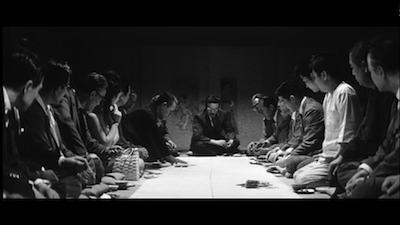
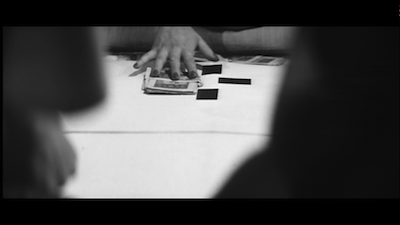
It's a gamble, but then, the whole of life is a gamble. The game of luck that Saeko and Muraki play is one of pure chance. The players randomly draw hanafuda, colorful dominoes with pictures on them, and place wagers on whether or not they will draw a match to the domino played by the lead gambler. It's a conundrum we regularly take in life: if I put myself out there, will this other person match up, will we be compatible. For Saeko, Muraki is a new kind of danger. She tells him at one point, "I'm so bored with life," and she uses him to find fresh excitement. What he sees in her glass-eyed expression is something only he knows. Maybe it's a kindred spirit, maybe it's himself as he once was, making her his second chance. Regardless, he's foolish to think it will make any difference. She so much as warns him. "Whatever happens, I forgive myself," she says. In other words, she lives for her own sake first, and whatever she has to do to bring herself whatever pleasure or contentment she can find, she'll do it, anyone else be damned.
It's enough to make you wonder who the real nihilist is here! Pale Flower's philosophical landscape is as desolate as any American film noir, and its actual landscape is shot with just as much of an emphasis on style and shadow. The black-and-white photography of Shinoda's regular cameraman, Masao Kosugi, plays with light and dark, shooting down narrow corridors, highlighting the distance between the dens of inequity and common life outside. Much of the action takes place on location, and so we also get stunning images of 1960s Tokyo, which at times can seem as unreal and dreamy as the paranoid nightmare Muraki has midway through the picture. This glimpse inside his sleeping mind is the only time we see Muraki truly unhinged; otherwise, Ryô Ikebe plays him as stoic and contemplative. His exterior expression is his most fundamental weapon, he can never let his true feelings show. In this, Mariko Kaga is his equal. The actress is just as strong at establishing a fictional mask--though she is also allowed brief bursts of devilishness. At one point, just before her high-speed drag race, the pair laughs together; after the race, she laughs alone, and it has a completely different pitch. It only grows darker later, when her giggle turns a sexual charade into a humiliating experience for Muraki.

In the end, Muraki is an anti-hero who can't escape his destiny. Whatever he thought he was going to accomplish turns to dust, his endeavors are as pointless as his denials. Arguably, his exile is far less of a punishment than it might seem, because being cut off from everything means he doesn't know how colossal his failure may actually be. That's the haunting coda of Pale Flower: awareness of life's absurdity brings no relief. Unlike Western existentialism, where one hurls oneself into the abyss in order to transcend it, the deeper Muraki peers into the blackness, the more it consumes him. He pushed his rock up the hill, rolled it over the other side, and now he only wants to get it back.
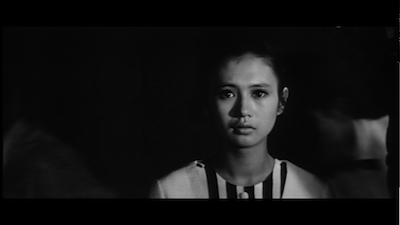
For a complete rundown on the special features, read the full review at DVDTalk.
Screen captures are from the original 2003 Home Vision Entertainment DVD-release, not the Blu-Ray.
Monday, May 9, 2011
SOMETHING WILD - #563
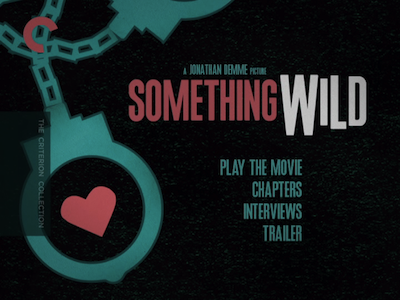
It's true what they say, you know, about how you always remember your firsts.
My sexual awakening can be traced through cinema thusly: I saw my first bra when my dad snuck me into National Lampoon's Animal House
My first pair of boobs was Caddyshack
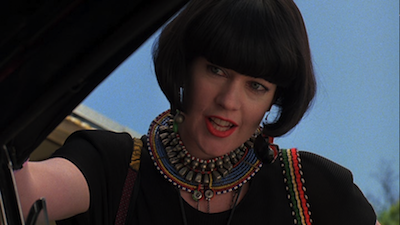
And the first time I remember being turned on by a sex scene in a movie and not grossed out was Something Wild. I was 14 and I managed to catch the off-center comedy on cable after hearing Siskel and Ebert enthuse over the film. It wasn't the first time I had seen sex in a movie--times had changed so much, my dad had taken me to see Scarface
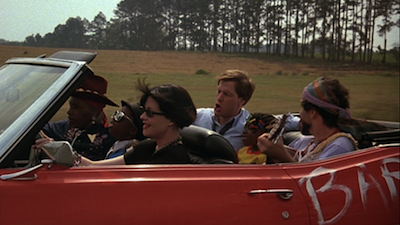
I am now more than twice the age I was when I first saw Something Wild. Hell, I think I'm at least twice the age I was when last I saw it. That VHS is long gone, and so is the quirky time in which a movie like Something Wild could be made without having its weirdo tendencies smoothed out by heavy market research. Melanie Griffith's portrayal of Audrey, a.k.a. Lulu, wouldn't fly anymore. For one, she'd be botoxed and body-doubled to the point of no longer actually looking like a real woman; for another, prevailing mores would dictate she would have to be broken somehow. Audrey predates the coinage of the "manic pixie girl" by nearly two decades, so she's not actually a victim nor does she have any kind of mental problem. Sure, the liberated woman whose past catches up to punish her for her freedom somewhat fits the victim bill, but Audrey's plight is more like something out of an old film noir than it is a product of post-modern malaise. She's a conwoman and a thief, after all, who picks up Charlie Driggs (Daniels) because she sees an easy mark that she can manipulate to going along with her schemes.
The way I see it, the whole of Something Wild's first hour or so is a movie that could only be from the 1980s. There is a kind of quaint naiveté to how Demme presents the seediness of city life and the criminal misadventure that finance-man Charlie finds himself on. He is a suburban husband and father who gets hijacked by a crazy girl who takes him on a road trip fueled with booze, sex, robbery, and lies--some hers, but some his. The suburbs has its secrets, too. Clearly something was in the zeitgeist, since 1986 was also the year David Lynch cracked the suburban egg in Blue Velvet
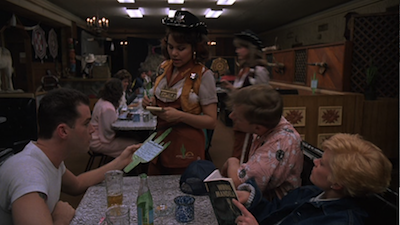
Digressing slightly, I had a similar reaction only just seeing Walter Hill's 1979 film The Warriors
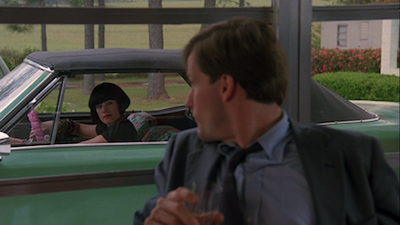
Charlie ends up on the free-love freeway, leaving job and family behind, meeting Lulu's mother, discovering her name is Audrey, pretending to be her husband, going to her high school reunion. To be fair, her real crimes are just out of sight whenever he's around, he doesn't know she's stealing and lying. That's just the thing, Charlie is oblivious. Thus, he's not going to see it when the harsh reality comes speeding at him like an oncoming truck--a simile I don't throw out just for the hell of it (it's too obvious on its own). Compare Charlie at the start of the film when he first chases Lulu across the street and nearly gets run over to the confident Charlie at the end who outwalks a city bus. In other words, traffic is a signifier!

A young Ray Liotta plays this harsh reality. He is Ray, a figure from Audrey's past and a real bad guy. He is jealous of Charlie, and so he puts his imagined rival right in harm's way. No plausible deniability if you're on camera while the convenience store gets robbed. The back and forth escalates between them, with Charlie getting the chance to play the hero, but also getting that heroism shoved back in his face. Sure, Audrey's appearance normalizes more and more as the movie progresses, but even that's a noir trope: the femme fatale is the dark-haired beauty, but the gal whom the protagonist eventually runs to is the more earthy blonde, the kind of girl who can wear a summer dress unironically. The change in either character is not so simple as just Audrey becoming grounded and Charlie letting go. Demme and Frye are working to subvert that, and even after all this time, the culmination of Ray's psychotic rage is still shocking. The climactic scenes of Something Wild are proportional in violence to the alternate feel-good image of a multicultural world that Demme builds elsewhere in the picture. The filmmaker really goes all the way in the showdown, and it's easy to forget that it's coming, to be as blind as Charlie, because the goofy romance can be real distracting.
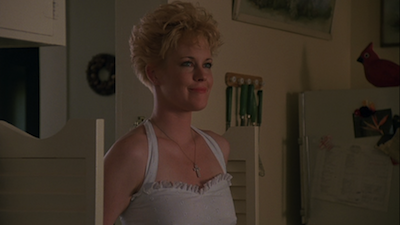
Which is really to say that Melanie Griffith can be real distracting. Something Wild kicked off a string of truly excellent performances from the actress. Or I should say, a string of excellent performances sprinkled in with a bunch of truly bad movies. Something Wild was such a flashpoint for Griffith, it's too bad she didn't make smarter choices after it came her way. Excepting her Oscar-nominated turn in Working Girl
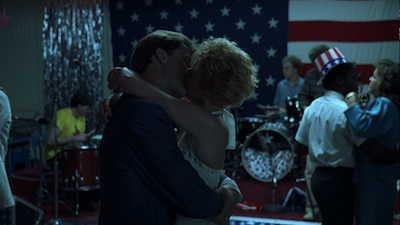
A lot of the Demme trademark touches are evident in Something Wild. He over directs the weirdness, creating characters and environments that are too quirky to ever truly breathe in the real world--Audrey's wardrobe, Audrey's apartment, Audrey--and yet he somehow makes them work. The high school reunion is one uninterrupted party with long cuts of the director's current favorite band (in this case, the Feelies) doing their thing. The humor is black, the violence is even blacker. In much the same way that Gus Van Sant was his most Van Sant-like in My Own Private Idaho, I think Something Wild is the purest form of Demme. They both might have made weirder movies and better, more substantial movies, but these choices show both of these arististc oddballs at their most peculiar and expressive. You can't imagine anyone other than Gus Van Sant making Idaho, and only Jonathan Demme could have made Something Wild.
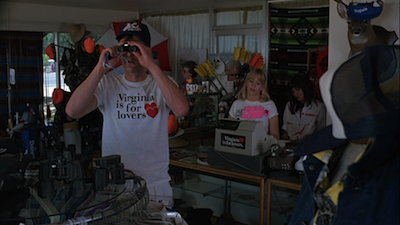
There is a lot going on in Something Wild that went right by me all those times I watched it as a teen. While it can be appreciated as the fun yet slightly sinister romp that it is regardless, there are deeper things about growing up and wrestling with nostalgia and dealing with the person you have become vs. the person you wanted to be that only have maximum impact after you've gathered a few years under your belt. For whatever strange notions about the world that Audrey has (to describe it as her mother did), the persona she has cultivated as Lulu is meant to both hide her identity (think Ava Gardner in The Killers) but also allow her to hang on to the kind of person she imagines herself to be--a little bit of a 1920s flapper, a little Bettie Page, a little Holly Golightly. (Okay, it's easier and easier to see what an influence that this had on my young psyche. The black stockings and the dark, bobbed hair alone....) By the time she gets back to her hometown, she is presenting herself as the woman her mother would have liked to see her become. By the time Something Wild ends, however, she has morphed into the woman she was always intended to be, an Eliza Doolittle of her own design, big hat and all, heading off to the races.
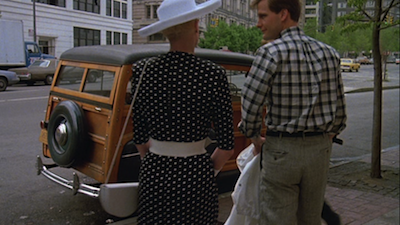
This disc was provided by the Criterion Collection for purposes of review.
Labels:
david lynch,
gus van sant,
jonathan demme,
walter hill
Tuesday, May 3, 2011
SMILES OF A SUMMER NIGHT (Blu-Ray) - #237
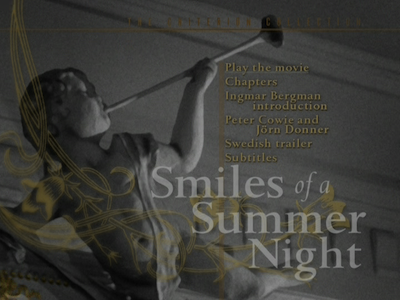
For those of you keeping track, if you really want to control a man, you need to take charge of three things: his heart, his words, and his loins. This, at least, is the truth according to the play within the film Smiles of a Summer Night and spoken in character by blonde actress Desirée Armfeldt, who herself is played by blonde actress Eva Dahlbeck. It's one of many miniature or mirror reflections within the grander design, each small refraction reflecting on the bigger picture, like Russian dolls or concentric circles within a whirlpool. Ah, such is love.
Smiles of a Summer Night is the 1955 romantic comedy from famed Swedish director Ingmar Bergman. Most often typecast as a sadsack, Bergman's sense of humor is regularly forgotten. (Dude, there's a fart joke in Fanny and Alexander!) The writer and director put Smiles of a Summer Night together when he needed a big hit, and hit he did. The film took a special prize at Cannes the following year, and an illustrious cinema career followed.

The story of Smiles of a Summer Night takes place over a series of days in the late-19th/early-20th century, culminating in an all-night party where the machinations of the previous events come together. It's a light comedy of errors, a semi-farcical love story with many players. Desirée loves Fredrik, but Fredrik's married to Anne, but Anne won't give up her virginity and rumor has it that Anne is getting with Fredrik's son, Henrik, who may or may not know that Fredrik and Desirée once had a thing. Meanwhile, Henrik, who is studying to be a priest, is lusting after the maid Petra, who advises Anne, and who also thinks Fredrik is kind of dreamy. Desirée is having an affair with Count Magnus, who is in an open-relationship with his wife Charlotte, but like most open relationships, the openness is one-sided. Charlotte is friends with Anne and so is caught between her devotion to a pal and her husband's jealousy over his mistress' old flame returning to her life. Meanwhile, Fredrik knows what he wants least of anybody.

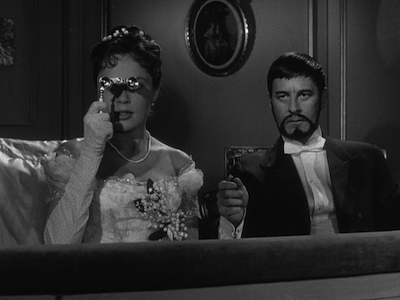
That description feels like it should be delivered in one giant breath, spoken as fast as possible so as best to communicate the madness of the soap opera. One is also tempted to break it down into a bawdy joke: the lawyer and the soldier fight over the actress, while the virgin and the priest consort with the hired help, etc. Bergman does similar himself a couple of times, using a cuckoo clock as a transitional connector in later scenes. The clock doesn't have an actual cuckoo, but instead a parade of carved figures pursuing each other in a circle as the hour is struck. There is the soldier and the maiden and the priest...and because this is Bergman, the Grim Reaper--though this too is a joke, a foreshadowing wink toward the film's final scenes when rivals engage in a dangerous game. It's another microcosm, the image within the image.

The final night serves as one of these miniature recreations, as well. The big party takes place at the country estate of Desirée's family. The actress has gathered her friends and their lovers in one final attempt to win back Fredrik (Gunnar Bjornstrand). She has made a pact with Charlotte (Margit Carlqvist) to enter into a mutual scheme to convince Magnus (Jarl Kulle) that the marriage bed is where he really wants to be, and with Fredrik distracted, maybe Anne (Ulla Jacobsson), who is secretly aware of her own husband's previous dalliance with Desirée after his first wife died, will finally enter into a joint release of carnal passions with her stepson (Björn Bjelvenstam). The whole thing actually takes on shades of A Midsummer Night's Dream when Desirée's mother (Naima Wifstrand) offers her guests a magical potion--wine that contains a drop of a woman's breast milk and a horse's semen--that is said to work as an elixir of love. It's probably just a placebo, but it definitely casts its spell.
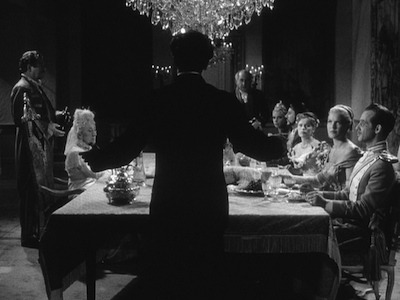
The movie's miniature summary comes that night from a different source, however. Petra (Harriet Andersson) has come along on the jaunt to serve Anne over the weekend, and she is paired off with the estate's groom, a jovial fellow named Frid (Ake Fridell). Frid immediately sets his sight's on the sexy blonde. It's a pairing of convenience, in a way, they are both workers, but it's also an intentional commentary on class. Bergman has set up that a major theme of the movie is how people love one another and how important the question of love is to each, and he notes multiple divides between different types of people. The most natural divide, obviously, is men and women, but social position also makes a difference. A lawyer approaches his sex differently than a soldier, just as Magnus' servant, who arrives with his master in an early automobile, views transportation differently than Frid, who takes care of the horses and drives his boss' carriage. Frid's flirtation with Petra is the most free and easy of any in Smiles of a Summer Night. The gregarious butler can chase and tease the lusty maid with as much abandon as he can muster. They aren't bound by the same restrictive mores as their employers. The game for them is really about play, while for the others, it's a more complex arrangement full of complicated rules, strategy, penalties, and of course, secrets and misdirection. There is even a difference in how the actors get to perform their roles. Andersson and Fridell are more physical and loose, and clearly more fun, whereas their counterparts are buttoned-up, starchy, and at times, comically emo.

But again, that mini-version: Frid explains the cycle of a summer night. It has three smiles. The first starts at midnight, and it's when young lovers surrender to their passions; the second is for the jesters and the literal fools, those undone by love or undoing it; the third and final, occurring in the wee hours before the new day, is for "the sad and dejected, for the sleepless and lost souls, for the frightened and the lonely." It's a relationship in 8 hours: the blossoming romance, the rash action, and the consequences. One can see this theory reflected in the three-act structure of Bergman's movie, as well: the introduction of all the relationships, the stupid things they do that cause them to begin unraveling, and the disconnect apparent at the party, when none of the lovers are with their most desired. Once the night is over and the sun rises, things are fixed, the lovers can return to the arms of their intended. Even Frid and Petra have found something by dawn's first gleamings.
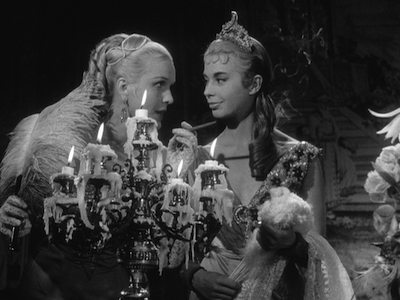
I should note, that while Smiles of a Summer Night has farcical elements and some truly funny lines--and even a little bit of slapstick (Fredrik ends up in a puddle, and then a frilly night shirt)--it's not a knee slapper. In fact, as it starts, you might not realize that it's a comedy at all. Bergman begins as if it were an erudite period drama. As the film progresses, he tweaks the conventions as one might tweak the nose of anyone taking himself too seriously, and lets the humor of the situation come out on its own. His characters, as so many people do in real life, become their own parodies. Our own selfish tendencies allow us to wallow in our moods and feelings until they become exaggerated, and if we can't laugh at ourselves at such times, don't worry, there will be plenty around to laugh in our stead.
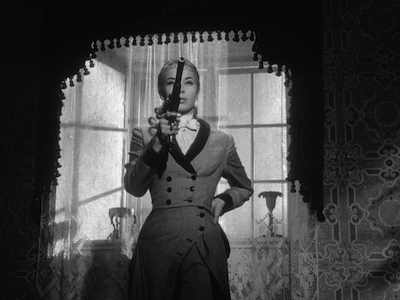
The one exception is Desirée. The actress is always in control, and Eva Dahlbeck, besides being physically gorgeous, gives the character an attractive internal confidence. She stands up for herself and fights for what she wants, but she's also good humored. Her laughing at Fredrik in the puddle seems so spontaneous--the tones of the chortle are full and genuine. Perhaps this is Bergman having his own laugh, subverting the notion of theater people as flighty and vain, getting a little back for his own. As a filmmaker, he's certainly in control. It's not the artist that is flaky, but all the folks with supposedly respectable careers. Maybe that's the punchline of the joke. The actress orchestrates the whole thing, and the priest, soldier, and lawyer are defenseless in her presence.
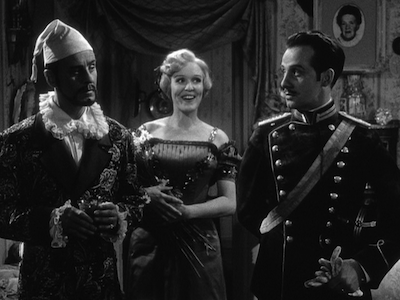
For a complete rundown on the special features, read the full review at DVDTalk.
Screen captures are from the DVD, not the Blu-Ray.
Subscribe to:
Posts (Atom)

